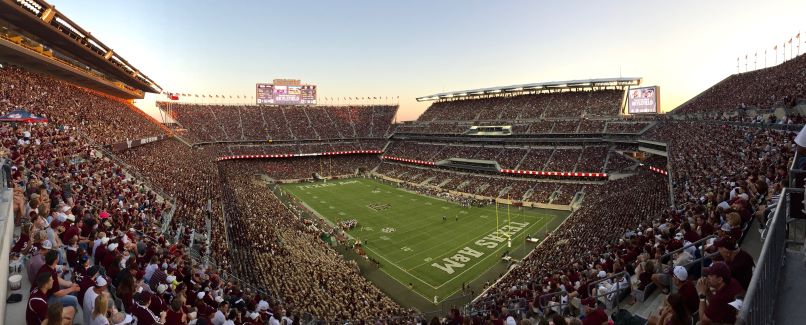Boise, ID. Recently, I witnessed one of the greatest upsets in college football history. By downing the then sixth ranked Texas A&M Aggies, the Appalachian State Mountaineers (who 15 years ago took down the Michigan Wolverines) cemented their status as the game’s mightiest David. Unfortunately for me, I was rooting for Goliath.
The idea of Texas A&M playing the role of the giant is an historical oddity. Though technically older, A&M has long had a striving “little brother” complex in a state where the University of Texas sat in the state capital of Austin and was showered with more financial resources and prestige than the farmer-focused rural campus in College Station. The isolation and the derision—Aggies have long been the butt of jokes—fostered an intense loyalty known as the “Spirit of Aggieland.” Some (only half-jokingly) refer to A&M as a cult. New arrivals to campus are indoctrinated into the faith at “Fish Camp” and then typically hold onto the school’s traditions fiercely. And Aggieland’s greatest rituals have always centered on football.
In the dark of night before a home game, thousands of students gather for Midnight Yell Practice. (Aggies don’t cheer, we yell.) A few hours later, thelargest student section in the land stands throughout the entire game. Those tens of thousands are honoring the example of E. King Gill, a student who at a bowl game in 1922 was called down from the press box at halftime to suit up for an injury-ridden team. Gill stood at the ready as the lone reserve throughout the rest of the game. The underdog Aggies went on to victory over the nation’s top ranked team and the tradition of the 12th Man was born.
An elegant life-sized statue of Gill long graced the entrance to Kyle Field, the Aggies’ football stadium. In 2014, though, the original statue was moved to a secondary location and a larger-than-life replacement (with square-shouldered look that suggested Dr. Frankenstein was the sculptor) took its place as part of a half-billion dollar (yes, billion) expansion of Kyle Field. This came shortly after the school entered the land of college football giants known as the Southeastern Conference. The awkward super-sizing of the 12th Man Statue epitomizes well the inflated role of football in today’s America.
The Chestertonian sentiment that “when Man ceases to worship God he does not worship nothing but worships everything” is apt here. As with many false gods, the problem is one of emphasis not essence. Because we are physical creatures, sports can play an appropriate role in the Kingdom of God. True, one could argue that today’s football is too violent, especially in light of the concussions that the game too regularly produces. The explosion of gambling surrounding the sport is also of real concern. One could, no doubt, add other problems to the list. Let me, however, here offer a few words on the benefits of football.
In an age of social collapse, football is an important institutional mortar for universities and more. For families divided by barriers of technology and culture, football is one of the few commonalities that can still cross generational lines. When mutual political resentments fester, a college or professional team is one of the few things upon which people can unite across partisan boundaries.
As C.S. Lewis said in The Four Loves, “Lovers are normally face to face, absorbed in each other; Friends, side by side, absorbed in the common interest.” At a time of mobility and dislocation, the common interest of football can draw friends together from thousands of miles apart, and, at least for a shared time in the stands, make friends of complete strangers. (Joining over 100,000 Aggies swaying together to the “Aggie War Hymn” is an experience not to be missed.)
One reason football brings us side by side is that the game provides the possibility of surprise. In these unscripted dramas, both elation and seeming devastation are possible within a three-hour span. We live vicariously through our champions on the field. When they succeed, we feel the rush of success. When they fail, we feel the disappointment. I often warn myself not to put too much of my emotional life in the hands of 18 to 22 year-olds, and yet experiencing the volatility of youth is key to the appeal.
And that brings me to my final reason to applaud football—the possibility of redemption. A week prior to their clash with the Aggies, the Mountaineers played the biggest home game in their history against the North Carolina Tar Heels. Some fans paid many hundreds of dollars to be there and were treated to a rollercoaster of a game that ultimately ended in a beyond dramatic 63-61 loss. The unexpected rebound on the road in Texas a week later set off pandemonium back in the streets of Boone. After another week had passed, fans who hadlast left Kidd Brewer Stadium bereft two weeks earlier would rush the field when a last second prayer of a pass was answered for a touchdown against Troy. Meanwhile, in Aggieland the despair of a humbling defeat was replaced by the joy of a new quarterback bringing victory over the nationally ranked University of Miami Hurricanes. Hopes for even grander accomplishments began to rise again at Kyle Field.
Sports can make us feel alive, even raised from the dead. To be sure, the dangers of idolatry and frivolous distraction are real. The gladiatorial games of Rome may have had many of the same unifying aspects as football. If beer and football are just the modern bread and circuses of a declining empire, then these are spectacles best avoided. However, if such gridiron microcosms of the human experience can unite us with our neighbors and point us to the bigger and more real story, then football, for all its flaws, deserves a yell, maybe two.














This piece brings back some old memories and feelings. One of my earliest childhood memories was of watching the Saints play the Steelers in an exhibition game on August 19th, 1967, in Tiger stadium in Baton Rouge. They won 20-17 before going on to win only 3 games in regular season. That they (the Saints) went on to have 20 losing seasons in a row finally dimmed whatever enthusiasm I had for the game. I never knew a team to find so many creative ways to blow a large lead. Many a Sunday afternoon witnessed my non-cursing father come up with creative ways to vent his disappointment. He died last year at 94. And he was eventually rewarded for his faithfulness to that team in the post 1987 years.
His devotion to football though found its purest expression with his (and mine) alma mater on Saturday nights listening to LSU. Every game night during the season he would toast some pecans and settle in at the kitchen table with the radio. I can still hear him shouting from the table, “go, Go! GO!”.
I have letters in my possession from him to his mother during WW2. While stationed on a destroyer off the shores of Iwo Jima he wrote to her asking for the scores on the LSU vs. Alabama game. Such as it ever was and always will be.
In fact, shortly before my aunt (my mother’s oldest sister died last year at a 100) She related a similar LSU family story (she also attended). In 1925 (October 10th) my grandparents took three ferries, from Crowley, LA, to attend the LSU vs. Alabama game, crossing the Atchafalaya Basin and the Mississippi river. LSU lost 42 to 0. They stayed the night with my great-great Aunt Mary before reversing the trip on Sunday.
Today I seldom get pulled into watching a game. But man do I hear the echoes on a cool fall Saturday night. Thanks for this, John. Time to roast some pecans and find my radio.
PS did you hear the one about the Aggie and his brother-in-law hunting deer….?
Brian, I hadn’t known you’re a fellow LSU alum. Geaux Tigers.
I had the distinct fortune of growing up right when both the Saints and the Tigers were at their best. I do remember the pre-Katrina Saints years of my childhood, though. Or rather, I remember the lack of any need to remember much of anything about the Saints.
And the only Saints game I’ve ever attended was a post-Katrina loss hosted at Tiger Stadium in Baton Rouge. Good times.
Thanks for the reply, Casey. A lot of schools have great traditions. Although you and I both know that no one tail gates a better party buffet than Tiger fans.
Comments are closed.